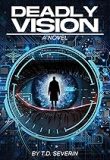Author Interview: T.D. Severin

The books shown on the left are by T.D. Severin Click on the cover to order.
This interview was conducted by Daniel Ryan Johnson on May 10, 2025.
Daniel Ryan Johnson: What was the spark of inspiration that got you started with the novel?
T.D. Severin: The concept of Deadly Vision is based upon a “what if?” What if there was a revolutionary medical breakthrough. A technology so advanced, people would kill to prevent its discovery. With the emergence of virtual reality, and advancements in computing and AI, I wanted to explore the concept of duality of existence, where someone could exist in the physical world and virtual world simultaneously, and how the existence in one would affect the existence in the other. As computing is becoming a bigger and bigger part of medical simulation, it seemed the next step would be to actually operate within that simulation, or not a simulation, as the case may be, but the real patient. I wanted to see how this process of duality of existence could drive someone insane, and finally, how it could be healing and lead to a change in the character. Basically, looking at medical science/technology, tweaking it a bit and seeing what the results could be.
In the end, the technology isn’t the star of the book however, it’s the character. And how his experience leads him to address the buried pain of his youth and find redemption. To me, the medical science/technology is only as interesting as the human element.
Daniel Ryan Johnson: Do you have a background in the field of medicine that you drew on, or are all the details purely research-based?
T.D. Severin: I’m a surgeon, Ophthalmic – Glaucoma Specialist, and a 30 year history of exploring virtual reality in medicine. I was one of the original doctors who explored the possible role of robotics in eye surgery. So the medical stuff all came from my experience as a medical student, resident, and surgeon, particularly the politics inside a major Medical Center. It’s a very nasty place.
Daniel Ryan Johnson: It feels like the virtual reality surgery could be used for a variety of ailments, such as removing tumors. Why did you choose heart disease as the focus for Taylor Abrahms?
T.D. Severin: I chose heart disease because the visual aspect of being inside the heart, inside a coronary artery is too amazing to ignore. I mean, how cool is that? To be actually standing inside a blood vessel, with blood cells whisking by you. Also, one of the main aspects is the self-propulsion of the laser inside the actual patient, while the doctor is inside the virtual simulation. This wouldn’t really work for cancers, as an incision would been to be made to reach the tumor.
Daniel Ryan Johnson: Both presidential candidates are portrayed as being pretty despicable. Was this a statement about current politics or more of a means of avoiding being too political with a bad guy and a good guy?
T.D. Severin: Personally, I have a rather dim view of our current state of politics, and think anybody from either party can be purchased with the proper incentive of money and power. In this story, I think both politicians are pretty much interchangeable. I could have flipped their party affiliations and it wouldn’t have had any impact on the story.
Daniel Ryan Johnson: Why did you choose to set the novel in San Francisco? Do you have a personal relationship with the city?
T.D. Severin: Yes, I grew up in a small town outside San Francisco, Danville, which also features prominently in the story. They say, “write what you know,” and I know this area. Most of the locations in the story, from the Franciscan Retreat in the hills above town, Bear Tree –where Jacob’s plaque is placed–, the walnut orchards to The Burgundy Inn in Yountville, are all real places. Geography was changed for the story, but all based on real locations.
Daniel Ryan Johnson: What is your writing process? Are you someone who carefully plans everything before you begin to write, or do you just sit down with a blank screen (or sheet of paper) and go?
T.D. Severin: A little of each. I definitely outline the story first, with the heroic journey – the through story– pretty clearly delineated. I know the basic cast of characters, the medical “what if” being explored and the theme. I then outline it pretty carefully, writing down each obligate scene as keywords onto a 3×5 card (yes, I’m very analog – I like the tactile experience). At the end, this 3×5 stack of cards is the outline of my book. Then when I sit down to write, I simply flip the card and know what comes next. This allows a lot of flexibility. I then allow the story to grow and ebb and flow as I’m writing, and new scenes and new characters seem to come in to fill story needs.
Daniel Ryan Johnson: The book has a pretty diverse cast of characters. Who was your favorite character to write?
T.D. Severin: Ha, yeah, thanks. It was a lot of fun. I loved writing Malcomb and all his quirks, and his developing relation ship with Helen. I think he’s become a “fan-favorite” I loved writing Ross because he’s so detailed and obsessive – I really reached into a different part of my brain to find him. Finally, my favorite character in the whole book is Dr Bennington Crawford. I just loved how pure and ethical his approach to medicine was.
Daniel Ryan Johnson: Were there other novels you have read that heavily influenced you when writing?
T.D. Severin: Absolutely. Michael Crichton is my biggest influence, I just loved the way he took science and weaved a story through it so you actually learned a bit while you read a great book. And it all seemed so believable. Preston and Child do this very well also. Then the great medical thriller writers who came before me like Robin Cook, Tess Gerritsen, and Michael Palmer. F. Paul Wilson wrote some good thrillers too.
Daniel Ryan Johnson: The novel highlights many issues with the U.S. healthcare system. Do you have any opinions about how these problems could best be addressed?
T.D. Severin: That’s a huge topic worthy of a dissertation. Let’s simply say, the problem with health care in this country is that we have a for-profit, third-party corporate entity (the insurance company) standing between the doctors and patients, dictating what can and can not be done (based on their own profitability – not medical science) while simultaneously raping 55% or more of the health care dollars away from the patient for their own operating costs and profits. It’s a system set up to fail, and to benefit no one but the insurances companies. You want to fix health care in this country, get rid of the insurance companies. Complex strategy and hard to do, but it would be the answer. I’ll outline details in my platform as I run for the Presidency in the 2028 election . . .. (just kidding!)
Daniel Ryan Johnson: Was Malcomb’s affinity for Nestle Crunch inspired by your own?
T.D. Severin: I’m a confirmed chocoholic, although I’m partial to dark chocolate. But yes, I do like a good Crunch bar. As a quirk, I wanted to give him something that represented his growing anxiety, and make it something pretty unique and something people could relate to. Malcomb obviously isn’t a drinker or a drug taker, so what “addiction” could I give him, where I could ramp up the intensity of the addiction in line with the ramping up of his anxiety. Chocolate!!
Daniel Ryan Severin: Thank you for taking the time to do this interview with me.
Ⓒ 2022 BestSellersWorld.com | All Rights Reserved | Design + Development by The Unglitch

